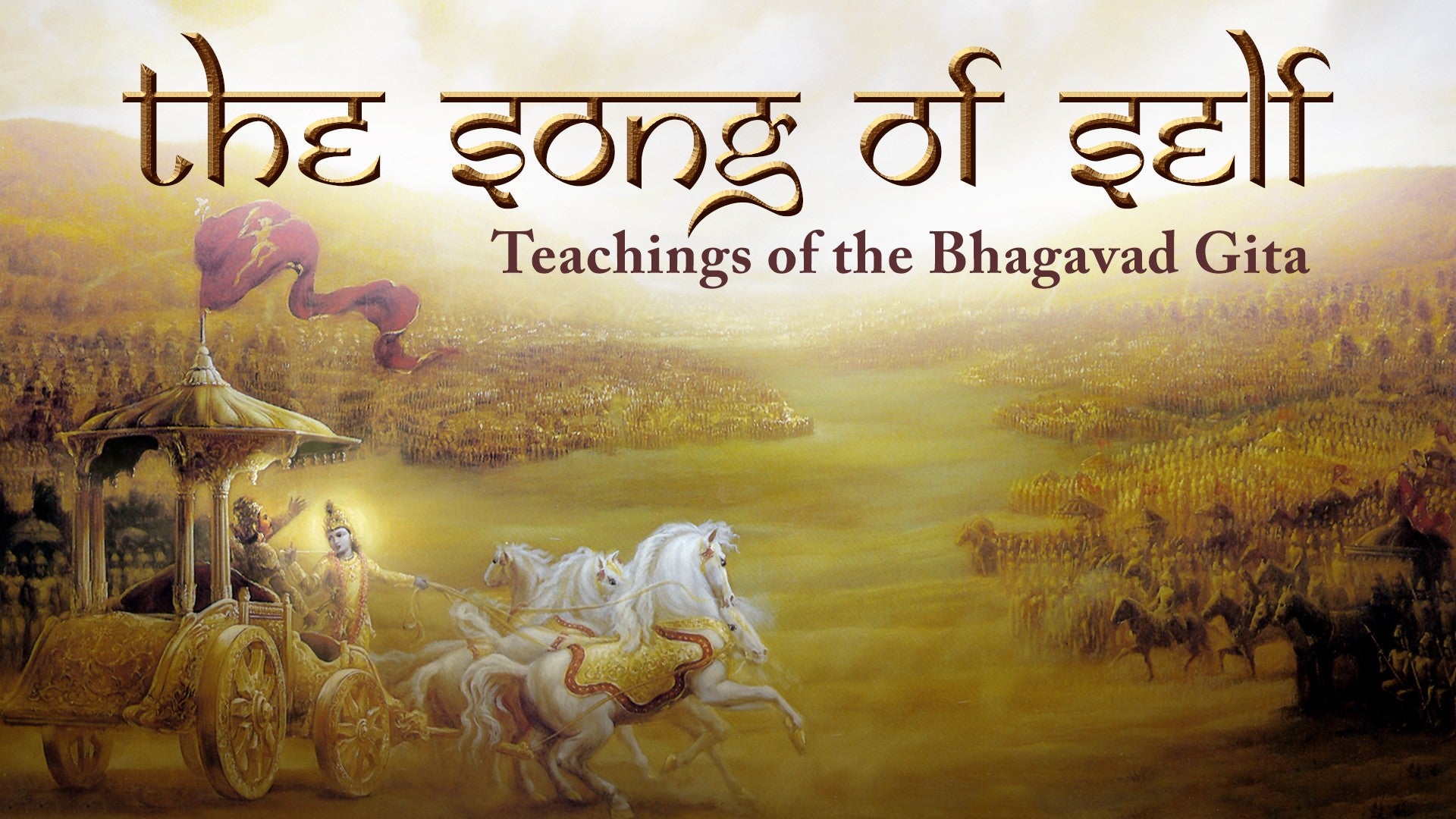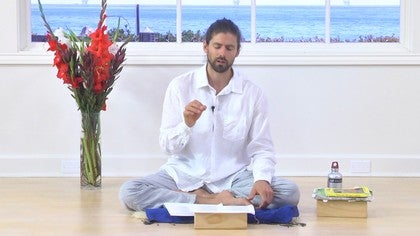Description
Join us by downloading the transliteration of Chapter 2. James begins to chant verse 2.1 at 2:45.
About This Video
Transcript
Read Full Transcript
So, welcome to this resource for developing a recitation practice, or cultivating a recitation practice of the second chapter of the Bhagavad Gita. What we're going to do now is a call and response section, taking us through the verses. We're going to start with the first ten, and in these first ten I'm going to recite one quarter of a line, in other words, eight syllables, and then I'm going to repeat it twice, and I invite you to repeat with me, so you'll hear it once, and then I'll repeat it twice. I invite you to chant along, sing along, recite along with me, and there'll be just a couple of instances where I might stop just to highlight a couple of points that maybe you can recite it in different ways sometimes, so we'll get to that when we come to it and that'll all make sense in context. So for now, also I'm going to say ata dviti yod chayah at the beginning.
This means, and now, chapter two, so we'll start with Aum together, you can join me if you like, and then we'll go into the recitation. Aum. And really, before we start reciting the Gita, I think it's actually appropriate that we include a short invocation to Ganesha, the energy that brings all parts of ourselves together, so we're just going to do a simple chant nine times, Aum Ganganapata Yena Maha. Join in with me if you like. And we've mentioned before in the course, this is basically inviting all parts of ourselves to work together, so we do the recitation practice, not just with our voice box, with our heart, with our mental focus, with all parts of the system.
Aum Ganganapata Yena Maha. Sanjaya Oacha, Tantata Kripayavishtam, and now repeating twice, Tantata Kripayavishtam, Tantata Kripayavishtam, Ashropurna Konikshanam, Ashropurna Konikshanam, Ashropurna Konikshanam, Vaishirantamiramvakyam, Vaishirantamiramvakyam, Vaishirantamiramvakyam, Vaishirantamiramvakyam, Vaishirantamiramvakyam, Vaishirantamiramvakyam, Kothasthva Kashmaramiram, Kothasthva Kashmaramiram, Kothasthva Kashmaramiram, Vaishami samupastetam, Vaishami samupastetam, Vaishami samupastetam, Vaishami samupastetam, Vaishami samupastetam, Vaishami samupastetam, Vaishami samupastetam, Vaishami samupastetam, Vaishami samupastetam, Nithat thvayyapapadityet ei, nithat thvayyapapadityet ei, nithat thvayyapapadityet ei, kshudram Shudram Redayadaurabaliyam. Shudram Redayadaurabaliyam. Shudram Redayadaurabaliyam. Tchaktwa Tishtaparantapa.
Tchaktwa Tishtaparantapa. Tchaktwa Tishtaparantapa. Arjuna Oacha. Ishabif pratyotsyami pujar havarisudanar pujar havarisudanar pujar havarisudanar gaurunahatvahimahanubhavan gaurunahatvahimahanubhavan gaurunahatvahimahanubhavan shreyo poktam paiksham api harokhe shreyo poktam paiksham api harokhe atvaita kamam stogaru nihayvam atvaita kamam stogaru nihayvam atvaita kamam stogaru nihayvam atvaita kamatvahimahanubhavan gaurunahatvahimahanubhavan gaurunahatvahimahan nihayvatvitm kataranogariyo nihayvatvitm kataranogariyo nihayvatvitm kataranogariyo atvaita kamatvitm kataranogariyo nihayvatvitm kataranogariyo nihayvatvitm kataranogariyo nihayvatvana jijeevishamaha nihayvatvana jijeevishamaha nihayvatvana jijeevishamaha nihayvatvana jijeevishamaha nihayvatvam jijeevishamaha nihayvatvam jijeevishamaha nihayvatvam kai panyadoshupatasvapavaha kai panyadoshupatasvapavaha kai panyadoshupatasvapavaha prichamitham thai misa muda chita, prichamitham thai misa muda chita, prichamitham thai misa muda chita, yachasya nishchitambru hitanme, yachasya nishchitambru hitanme, yachasya nishchitambru hitanme, shishyasteyam shatimam tambrapanam, shishyasteyam shadimam tambrapanam, shishyasteyam shatimam tambrapanam, nahi prapasyamimam apanudyat, nahi prapasyamimam apanudyat, nahi prapasyamimam apanudyat, yachoka mochoshanam indriyanam, yachoka mochoshanam indriyanam, yachoka mochoshanam indriyanam avapya pumaavasapatnamrattam, avapya pumaavasapatnamrattam, avapya pumaavasapatnamrattam rajamsurana mapechadepatyam, rajamsurana mapechadepatyam, rajamsurana mapechadepatyam, sandraya mappusapata ishikesham, vamuk valyashigesham, vamuk valyashigesham, vamuk valyashikesham, gurd prosperity, gurd380 pharantapah, gurd agonyt tharantapia, gurd Gurdakeshav Parantapa, Gurdakeshav Parantapa, Nayotsya, Etigovindam, Nayotsya, Etigovindam, Nayotsya, Etigovindam, Oktratushnim Babu Waha, Oktratushnim Babu Waha, Oktratushnim Babu Waha, Tamu Agchari Shri Ke Shaha, Tamu Agchari Shri Ke Shaha, Tamu Agchari Shri Ke Shaha, Prasannyavabharata, prasannyavabharata, prasannyavabharata, seinayorebhayurmati, seinayorebhayurmati, seinayorebhayurmati, vishirantamiramacha, vishirantamiramacha, vishirantamiramacha. So here, the first ten verses, and in these first ten we've already encountered two different meters.
To mention the beginning, most of the verses, the vast majority, are 32 syllables, four eights. But in these verses, we've been introduced to this second meter which features in the second chapter, and we'll encounter it again in verses 20, 22, 29, and the seventieth verse. So with these ten, we've already basically covered the metrical forms we're going to encounter the rest of the chapter, and we've already started to train the tongue. So having repeated these verses twice, in the next section, from 11 to 19, we're just going to repeat it once.
The Song of Self: Let's Recite
Comments

You need to be a subscriber to post a comment.
Please Log In or Create an Account to start your free trial.











